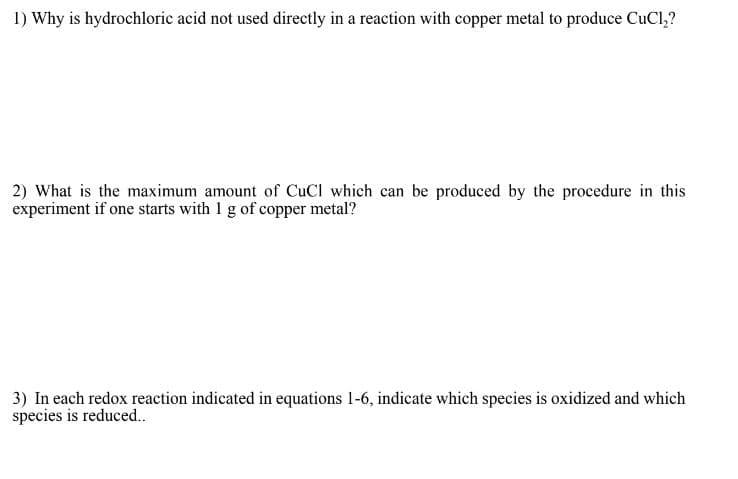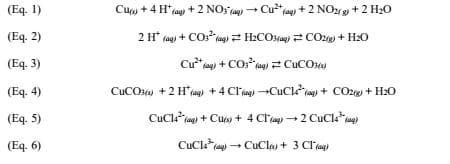Introductory Chemistry: A Foundation
9th Edition
ISBN:9781337399425
Author:Steven S. Zumdahl, Donald J. DeCoste
Publisher:Steven S. Zumdahl, Donald J. DeCoste
Chapter18: Oxidation–reduction Reactions And Electrochemistry
Section: Chapter Questions
Problem 84AP: . For each of the following unbalanced oxidation-reduction chemical equations, balance the equation...
Related questions
Question
question 3

Transcribed Image Text:1) Why is hydrochloric acid not used directly in a reaction with copper metal to produce CuCl₂?
2) What is the maximum amount of CuCl which can be produced by the procedure in this
experiment if one starts with 1 g of copper metal?
3) In each redox reaction indicated in equations 1-6, indicate which species is oxidized and which
species is reduced..

Transcribed Image Text:(Eq. 1)
(Eq. 2)
(Eq. 3)
(Eq. 4)
(Eq. 5)
(Eq. 6)
Cus) + 4 H* (aq) + 2NO3(aq) → Cu²+ (aq) + 2 NO₂(g) + 2 H₂O
2 H* (aq) + CO3² (aq) = H₂CO3(aq) CO2(g) + H₂O
Cu²+ (aq) + CO3(aq) CuCO3(6)
CUCO3(s) + 2 H+ (aq) + 4 Cl(aq) →CuCl(aq) + CO2(g) + H₂O
CuCl(aq) + Cu(s) + 4 Cl(aq)-2 CuCl4³(aq)
CuCl(aq) → CuClo) + 3 Cl(aq)
Expert Solution
This question has been solved!
Explore an expertly crafted, step-by-step solution for a thorough understanding of key concepts.
This is a popular solution!
Trending now
This is a popular solution!
Step by step
Solved in 2 steps with 1 images

Follow-up Questions
Read through expert solutions to related follow-up questions below.
Knowledge Booster
Learn more about
Need a deep-dive on the concept behind this application? Look no further. Learn more about this topic, chemistry and related others by exploring similar questions and additional content below.Recommended textbooks for you

Introductory Chemistry: A Foundation
Chemistry
ISBN:
9781337399425
Author:
Steven S. Zumdahl, Donald J. DeCoste
Publisher:
Cengage Learning

Chemistry
Chemistry
ISBN:
9781305957404
Author:
Steven S. Zumdahl, Susan A. Zumdahl, Donald J. DeCoste
Publisher:
Cengage Learning

Chemistry: Matter and Change
Chemistry
ISBN:
9780078746376
Author:
Dinah Zike, Laurel Dingrando, Nicholas Hainen, Cheryl Wistrom
Publisher:
Glencoe/McGraw-Hill School Pub Co

Introductory Chemistry: A Foundation
Chemistry
ISBN:
9781337399425
Author:
Steven S. Zumdahl, Donald J. DeCoste
Publisher:
Cengage Learning

Chemistry
Chemistry
ISBN:
9781305957404
Author:
Steven S. Zumdahl, Susan A. Zumdahl, Donald J. DeCoste
Publisher:
Cengage Learning

Chemistry: Matter and Change
Chemistry
ISBN:
9780078746376
Author:
Dinah Zike, Laurel Dingrando, Nicholas Hainen, Cheryl Wistrom
Publisher:
Glencoe/McGraw-Hill School Pub Co

Chemistry: Principles and Reactions
Chemistry
ISBN:
9781305079373
Author:
William L. Masterton, Cecile N. Hurley
Publisher:
Cengage Learning

World of Chemistry, 3rd edition
Chemistry
ISBN:
9781133109655
Author:
Steven S. Zumdahl, Susan L. Zumdahl, Donald J. DeCoste
Publisher:
Brooks / Cole / Cengage Learning

Chemistry by OpenStax (2015-05-04)
Chemistry
ISBN:
9781938168390
Author:
Klaus Theopold, Richard H Langley, Paul Flowers, William R. Robinson, Mark Blaser
Publisher:
OpenStax